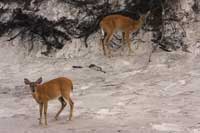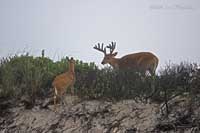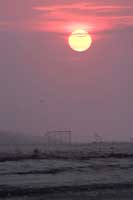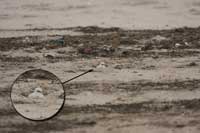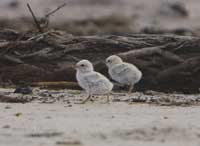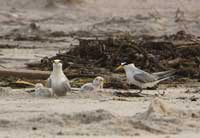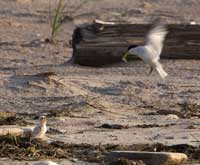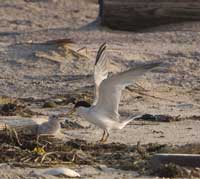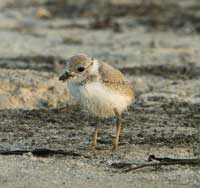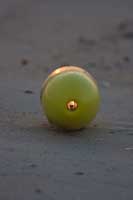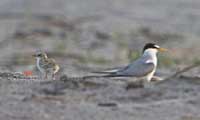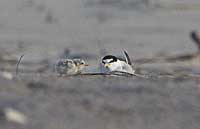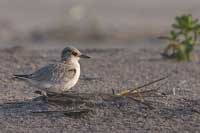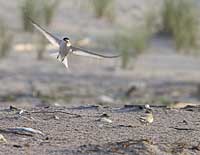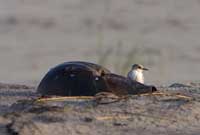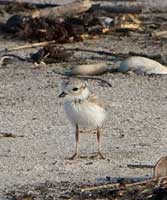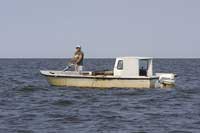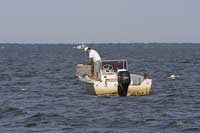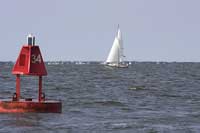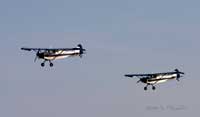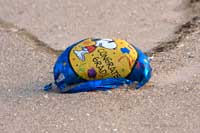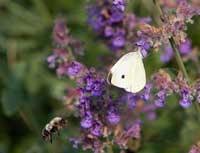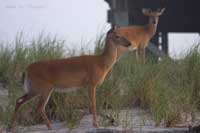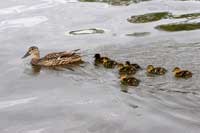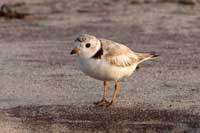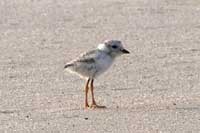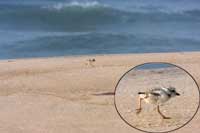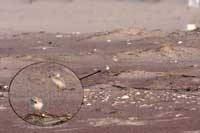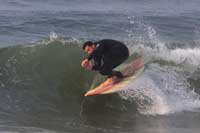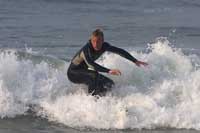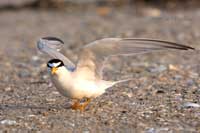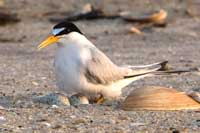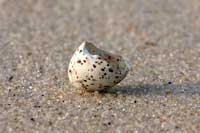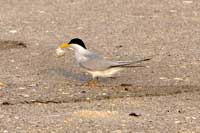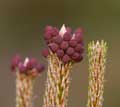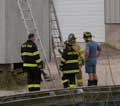Couple of Does. On my way to the shorebird nesting
area. It looks like these two couldn't figure out if I was a threat or not.
Mating pair? This is one of the does from the previous
shot. At first, all I saw were the antlers of this ten-point buck. He complied
to my fervent hope that he show more of himself.
Sunrise over the nesting area. You can see a piping
plover enclosure and a distant lifeguard stand at the public beach beyond it.
Tern
chicks in hiding. As I approached the protected nesting area, I spotted two
chicks dashing on the sand. The parents started buzzing me, which is standard
procedure for a threat. (They always stop once I stop moving and sit on the sand.)
Just before I got this shot, I witnessed a behavior that makes you think, "Did
I really just see what I thought I saw?" One of the parents finished a buzzing
run and veered directly toward this chick, who was walking about in full view.
I can only imagine what went through the mind of the parent. Without breaking
it's flight, it swooped down on the little one and with its feet stomped it down
into this hollow. Amazing. There are two chicks in this image. Can you find the
other one?
Siblings. I think these were the same two chicks
that were hiding. They showed no regard for my presence some 80 feet away outside
the protected area. This was taken with a 200mm telephoto with a 1.4 extender,
which is not quite up to the task, as you can see from the grainy nature of this
shot. But the next size lens is quite expensive.
Here's the whole family. One parent stayed with the
chicks while the other hunted for small fish. You can't tell from the image, but
the bird on the right just fed the chick.
Breakfast! As you can no doubt tell from the blur
of the parent, they are fast. You have not chance of catching them in flight.
I kept my eye on the baby. When it popped up and opened its beak, I knew the parent
was about the enter the image.
A second later. Aren't parents great?
Piping Plover chick. Even though I set up outside
of the protected area, I do worry about the possibility of my presence disturbing
these endangered and protected species. Apart from my overall concern for their
welfare, it is a federal offense to harass them, with a potential fine of $20,000.
So, I was comforted to note that, while I was watching the tern family, this piping
plover chick came within 20 feet of me, apparently regarding me as having the
same potential lethality as debris washed up on the last high tide. Come to think
of it, I've known some women who seemed to have that same perception.
Fire Island Sunrise. On my way to the protected nesting
area. The way I phrased that is probably misleading. That's not me in the image.
Is this washed up buoy on fire? I first saw this
from the distance. It looked like it had a light in it. As I approached, I realized
that it was the rising sun reflecting off the inner wall of the shaft.
Mother and child. Not a great technical shot, but
I considered myself fortunate to get the two of them in one image.
Another shot. Of the same pair.
Older tern chick. There seemed to be tern chicks
of all ages.
Same juvenile. Here's the parent checking on him/her.
What's this thing? The same juvenile as in the previous
two images. It was wandering about looking at objects that drew its attention.
This abandoned horseshoe crab molt got a lot of scrutiny.
Piping Plover chick. These are a tough subject. They're
fast and small and won't come closer than some50 feet. I'm still trying to get
a good shot. This image is a major crop.
Bayman. On the way back home, I passed this fellow
plying his trade.
Another bayman.
Sailboat. Not a great shot, but I liked the juxtaposition
of the sailboat and the buoy. it would have been better if the sailboat had been
closer.
Airplane Pair. This was taken at Smith Point Count
Park. They reminded my of a 14 June shot, but double.
Sea
life murder weapon. Great fun, huh, kids? You wouldn't think so if you knew
that many helium balloons end up in the ocean. Sea turtles think that it's food.
Dolphins play with them and may eat them too. Then they are condemned to a slow
and painful death by starvation with a belly full of plastic gargage that their
digestive systems can't pass.
Truck
stop. One of the plants growing along the main walkway at Davis Park, apparently
full of nectar.
Deer in Early Morning Mist. I could have punched up
the image, but decided to leave it as it actually appeared.
Mallard family. Mom and kids in the Browns River.
Piping Plover adult. The babies have hatched. They
are extremely difficult to see. More likely, you will know that they are nearby
when the adults pipe. They are trying to attract your attention so that you will
leave alone their flightless hatchlings.
Piping Plover chick. This image is a telephoto shot,
cropped heavily, which is why it's not a great image. It's impossible to get close
to these fellows. This one was 15 meters away from me.
All legs. They have been described as balls of cotton
on tooth picks. The main shot is out of the camera, taken with a long lens. The
inset is the cropped image. It's amazing to see these little ones scoot across
the sand. They're so small, but they move their legs in a blur.
Find the piping plover chicks. Their feathers match
the color of the beach so well that you'd probably miss them unless they started
moving.
Surfer dude. The surf was up on a misty morning. My
first surfer shot ever.
Surfer dude number II.
Tern. I'm still trying to catch the black on black
eye.
Tern with eggs. Just as he/she had fluffed her feathers
to settle on the eggs.
Tern eggshell. I saw two of these on the beach. The
life of a shore bird is a hard one. The eggs and hatchlings are defenseless, depending
on their parents to use distraction, aggressive swoops, and guile to protect them
from gulls, foxes, pet dogs, big-footed people, and vehicles. All too often, they
lose, which is why the piping plover is an endangered species. This eggshell was
probably taken by a gull, since it wasn't crushed.
Distraction. Here's an example of the guile about
which I wrote in the previous frame. This tern might have been reacting to my
presence, even though I was outside the protected area and down slope of the high
tide line. He picked up the shell, flew away, dropped it, and faked going after
it, "failing" to catch it. I hypothesize that he was hoping that I would
chase him and try to steal the morsel, which is what a gull might do.
Enclosure. A piping plover can be seen in the middle
on its nest, which is basically a hollow in the sand.. Their eggs are almost indistinguishable
from sand and pebbles and are easily crushed by people, pets, and vehicles, which
are not allowed in the protected area. The fencing was built around the nest after
the birds created it. It's purpose is to keep dogs and foxes from attacking the
nest.
Warning sign. Forbidding access to the area for vehicles
and pets. Notice the tracks to the left of the sign to see how effective it is.
When I was leaving, I noticed two people bring dogs on the beach from the east
end. I assume the same signs were up at that end.
Another warning sign. On the cordoned off area in
which terns, plovers, and oyster catchers nest. Notice footprints heading into
the area, suggesting that some people do not believe that the signs apply to them.
Because plover and tern eggs are so difficult to see, it is likely that the person
who made these footprints crushed some eggs.
Proof. Here is a shot of plover eggs, taken with a
telephoto lens from outside the cordoned off area. If you were standing right
over the nest, it would still be difficult to pick out the eggs.
White
Foxglove. These bloom all over Davis Park on Fire Island in the spring and
early summer. Most of them are the pink variety. Here is a rarer white one. They
are extremely poisonous to people and pets if eaten. Bees, however, don't seem
to have a problem with them.
Pink Foxglove. This one is actually growing in my
yard. However, it is three blocks in from Great South Bay. I can hear surf on
windy days. So I'm exercising artistic license by including it.
Water Lily. Okay, I'm cheating again. Water lilies
are fresh water plants. Great South Bay is salt water. This one is in my yard.
Airplane. Back on Fire Island, a plane flying low
over the ocean one morning.
Common
Tern. These remarkably swift and agile flyers nest in the Watch Hill protected
area. Getting a passable shot of them in flight is a great challenge. This one
is bringing breakfast to a mate or younguns.
Tern Eggs. The parents located their nest close to
the boundary of the roped off area. While they were away from the nest, I took
a quick shot from outside the boundary. If I hadn't seen the parent on the nest,
I would never have seen the eggs. Even though I knew their general location, I
could only see them through my telephoto lens.
Rhododendron. These were growing outside the Catholic
Church at Davis Park in early June.
Horseshoe Crab. These critters are as ancient as the
dinosaurs. Yet they are imperiled by (until recently) unrestricted harvesting
for eel and conch bait. They come ashore in Spring to lay eggs, which provide
a feast for shorebirds.
Tipped over. The tail, or telson, of the horseshoe
crab is not a weapon, as many people believe. It's main use is demonstrated here:
helping to right the critter when it is tipped over by wave action. If you find
a live horseshoe crab stuck on the beach, do not pick it up by the telson, which
will harm it. Carry it to the water by holding the edges. They are harmless.
Pine Flower. Or baby pine cones, or buds -- I'm not
sure which.
Beach heath. A native wildflower that grows in the
dunes on Fire Island.
Love is in the air. A male tern offers a fresh fish
to the object of his affection.
Playing hard to get. She ignored him for minutes on
end. He even dragged the fish under her beak at one point. It looked like she
was holding out for the Brad Pitt of the tern world.
Back off! All he wanted was to be her friend.
At last! His solicitations finally paid off.
Flock of shore birds. They might be oyster catchers.
I'm not sure.
Yellow
throat. That's the name of the species, as well as the color of its throat.
Davis Park at night. Looking toward the bay.
Davis
Park Fire Department. Contrary to snide remarks that you might hear, the Davis
Park Fire Department takes its business seriously.
Summertime Leisure. Here's a fellow taking full advantage
of a cool summer morning.
Sailing back. If the conditions are right for taking
out the camera, I can often get shots of boats under way. Here is a bayman digging
for clams. Long Island was once renowned for its clams. However, the industry
collapsed, being the victim of overfishing.
Power boat.
Another.
Double ender sloop.
Gaff-rigged sloop. Almost a catboat. The unset jib
sail in the front makes it a sloop. Before the age of power, the wide beam and
shallow draft of the Long Island catboat was the prefered vessel for oystering
-- another failed industry.
Leg-powered kayak. In the Browns River, which is my
sailboat's home port.
